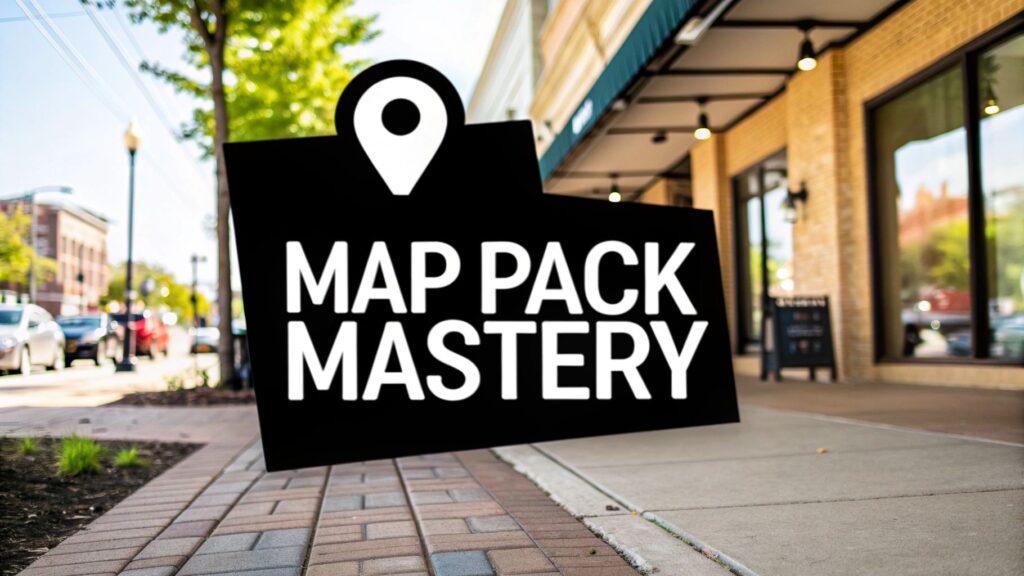Word-of-mouth referrals are great, but they only go so far. Your next client is likely searching for a massage on their phone right now.
This is why massage therapist SEO is so important. It's the most reliable way to keep your schedule full and your business growing. SEO creates a direct line from someone's online search to your booking calendar.
Why SEO Is Your Best Client Magnet
If marketing feels like shouting into the void, SEO is your new best friend. It flips the script. Instead of you chasing clients, SEO helps clients who are already looking find you.
When people are in pain or need to de-stress, they go straight to Google. They have a specific, often urgent, need.
This is where your practice can step in. By optimizing your online presence, you show up when someone types "deep tissue massage near me" or "sports massage in [Your City]." It connects you directly to people who need your exact services.
In Short: A critical piece of the puzzle is local search. People searching for a local massage therapist are usually ready to book an appointment right away. Optimizing for these searches helps you capture high-intent clients.
Core Components of Massage Therapist SEO
To get this right, break down your SEO plan into a few key areas. Each part helps build your online visibility and attract the right clients.
Here’s a quick rundown of the essential pillars for an effective massage therapy SEO strategy.
| SEO Pillar | Primary Goal | Key Actions |
|---|---|---|
| Local SEO | Appear in "near me" searches and Google Maps. | Optimize Google Business Profile, get local reviews. |
| On-Page SEO | Make your website clear to Google and users. | Use keywords on service pages, create clear headings. |
| Content Creation | Build trust and answer client questions. | Write blog posts about benefits, create service FAQs. |
| Link Building | Show Google your practice is credible and trusted. | Get mentions from local wellness blogs or directories. |
Think of these as building blocks. Get them right, and you'll have a solid foundation for attracting a steady stream of clients.
From Search Query to Loyal Client
Think about the last time you needed a plumber or a new restaurant. You probably did a quick search on your phone. Your potential clients are doing the exact same thing.
SEO closes the gap between their problem and your appointment book.
This process builds a sustainable pipeline of new clients. You don't have to constantly hustle like with old-school advertising. Your website and Google Business Profile work for you 24/7.
"Your ideal client isn't waiting for a flyer. They're on Google right now, searching for a solution to their pain. SEO puts you right in their path."
While SEO is powerful, it’s just one part of a successful practice. As you bring in more business, explore different strategies for scaling a service business to handle the growth. A strong SEO foundation helps you build a resilient, thriving practice.
Finding the Keywords Your Clients Actually Use

To get more clients, you have to think like them. Great massage therapist SEO is about figuring out the words people use on Google when they're in pain or stressed.
It’s about getting past a generic term like "massage" and tapping into what your clients are really searching for.
Someone with a nagging shoulder injury isn't just looking for a "massage." They’re more likely to search for "deep tissue massage for shoulder pain in [Your City]."
These longer, specific phrases are called long-tail keywords. They are SEO gold because they show a clear intention to book an appointment. Your goal is to find these high-intent keywords that match your services.
Start by Brainstorming Your Core Keywords
Before you open a browser, start with what you know best: your practice. List out the different services you offer.
Be specific.
- Swedish Massage
- Deep Tissue Massage
- Prenatal Massage
- Sports Massage
- Myofascial Release
- Hot Stone Massage
Now, think about your ideal client for each service. What problem are they trying to solve? This helps you add their "pain points" to your keywords, making them more effective. For example, "prenatal massage" becomes "prenatal massage for lower back pain."
Use Free Tools to See What People Are Asking
You don't need expensive software for keyword research. Google itself is one of the best tools, and it's free.
Start typing one of your core services into the search bar. Google’s autocomplete will show you what other people are looking for.
After you search, scroll down to the "People Also Ask" box. This is a goldmine of questions your potential clients have.
For instance, a search for "deep tissue massage" might show questions like:
- How often should you get a deep tissue massage?
- What is the difference between Swedish and deep tissue massage?
- Is a deep tissue massage supposed to be painful?
Each question is a great idea for a blog post or a section on your service page. Answering them directly on your site shows your expertise.
The Big Takeaway: Your keyword strategy shouldn't just be about your services. It needs to be about the specific problems you solve.
Get a Handle on Keyword Intent
Finding keywords is half the job. You also need to understand the search intent behind them. What is the person searching actually trying to do?
There are a few main types of intent:
- Informational: The person wants to learn something (e.g., "benefits of sports massage").
- Navigational: They're trying to find a specific website (e.g., "[Your Practice Name]").
- Commercial: They're researching before they commit (e.g., "best massage therapist in [Your City]").
- Transactional: They're ready to book (e.g., "book deep tissue massage online").
Your service pages should target commercial and transactional keywords. Your blog is perfect for informational keywords to build trust. Understanding your audience is how you choose the best keywords for your SEO strategy. This principle applies to any local service, from marketing a massage practice to learning about SEO for contractors.
Becoming the Go-To Therapist in Your Area
For a hands-on business like massage therapy, your local community is everything. Your success depends on showing up when it counts—right in your neighborhood.
Mastering your local massage therapist SEO makes that happen. The goal is simple: when someone nearby searches for a massage, your practice needs to be the first choice.
This is your playbook. We'll cover how to optimize your Google Business Profile, get positive reviews, and keep your business details consistent online. It's more about smart strategy than complicated tech.

As this image shows, making small, intentional tweaks to your website can completely change how search engines see your practice, leading to serious growth.
Supercharge Your Google Business Profile
Think of your Google Business Profile (GBP) as your digital storefront. For local searches, it's often the first thing a potential client sees.
An incomplete profile is a massive missed opportunity. Google says businesses with complete profiles are 2.7 times more likely to be seen as reputable.
To make your profile a client magnet, treat it like a mini-website.
- Fill Out Everything: Don't skip sections. Add your hours, services, and check your address and phone number. This info—your Name, Address, and Phone number (NAP)—must be identical everywhere online.
- Pick the Right Categories: Your primary category should be "Massage Therapist." Also add secondary categories like "Sports Massage Therapist" or "Medical Spa."
- Show Off Your Space: Upload quality photos of your treatment rooms and building exterior. Businesses with photos get 42% more requests for driving directions.
What Do People Ask About Local SEO?
Let's clear up a few common questions therapists have about local search.
- How do I show up on Google Maps?
It starts with claiming and fully optimizing your Google Business Profile. Ensure your address is accurate, select all relevant categories, and actively encourage reviews. - What are local citations?
Citations are online mentions of your business's name, address, and phone number (NAP). Think of directories like Yelp or Yellow Pages. The key is consistency—every citation must match your GBP perfectly. - Do reviews really matter for local SEO?
Yes, they're huge. Positive reviews act as a massive trust signal for clients and Google. It tells Google you're a legitimate, high-quality business.
Build Social Proof with Client Reviews
Reviews are modern word-of-mouth. Research shows that 76% of consumers read online reviews for local businesses. A collection of positive reviews can convince someone to book with you.
Getting them doesn't have to be awkward.
Just ask. At the end of a great session, ask a happy client to share their experience online. Send a follow-up email with a direct link to your Google review page to make it easy.
Pro Tip: Responding to every review—good or bad—is just as important. A thoughtful reply shows you're an engaged business owner who cares about feedback.
This isn't just theory. A case study on a New York City massage therapist showed how a focused local SEO strategy took their practice to the #1 ranking in Google Maps in just seven months. It created a reliable flow of new clients.
The principles of local SEO are universal. Whether you're a massage therapist or you're learning about SEO for contractors, it all comes down to being visible and credible to your community.
Building a Website That Screams "Trust Me, I'm a Pro"

Your website is often the first "handshake" with a potential client. It's where they decide if they trust you. A solid massage therapist SEO strategy is about more than keywords; it's about building a website that radiates expertise.
Think of your site as your virtual studio. It needs to feel professional, clean, and welcoming. For Google, this is about E-E-A-T (Experience, Expertise, Authoritativeness, and Trustworthiness).
Health and wellness topics are what Google calls "Your Money or Your Life" (YMYL). They are held to a much higher standard.
In Short: Getting E-E-A-T right is a big deal. Creating robust team pages with each therapist's credentials, experience, and specializations is a powerful way to do this. This one move has been shown to boost organic traffic for massage sites by as much as 86%.
Stop Lumping Your Services Together
I see this all the time: a single "Services" page with a bulleted list of massage types. This is a huge missed opportunity. If you offer five different modalities, you should have five dedicated service pages.
Each page is a chance to educate a potential client. Don't just list the service; bring it to life.
- Your Swedish Massage Page: Talk about how it melts away stress and promotes relaxation. Describe the long, gliding strokes.
- Your Deep Tissue Page: Explain that it's designed to release chronic muscle tension. Clarify who it's for, like athletes or people with back pain.
- Your Trigger Point Therapy Page: Demystify the process. Explain how you focus on "knots" to release tightness and pain.
For every service, answer the big questions: What happens during the session? What are the benefits? Who is this treatment perfect for?
Don't Hide Behind Your Logo—Show Them Who You Are
People don't just book a massage; they book a massage with you. Your 'About Me' or 'Our Team' page is your most powerful trust-building tool. This is where you become a real person.
My Two Cents: Your 'About Me' page is where the magic happens. It’s where your story, credentials, and passion come together to make someone feel ready to book.
Make sure your page clearly lays out:
- Your Credentials: List your licenses, certifications, and specialized training.
- Your Experience: How many years have you been practicing? Do you have experience with certain conditions like sciatica? Say so.
- Your "Why": Share a bit of your story. Why did you become a massage therapist?
This personal connection makes a visitor feel like they know you. That's how you turn a maybe into a booking.
Become the Go-To Resource with a Killer Blog
A blog is the best way to prove you're a wellness authority. It's your platform for answering the questions your clients ask every day. This is the heart of a great massage therapist SEO strategy.
Think about the conversations you have in your treatment room. Every question is a potential blog post that could attract new people.
Blog Ideas Ripped Straight from the Clinic:
- "Can Massage Help My Tension Headaches?"
- "Top 3 Things to Do After a Deep Tissue Massage"
- "5 Stretches to Undo 'Desk Slump' Neck Pain"
- "Is Sports Massage Just for Pro Athletes?"
When you create helpful content, you're building a reputation as an expert. You can also cover related topics, like offering insights on preventing repetitive strain injury—something many clients deal with.
Easy On-Page SEO Tweaks for Big Results

You don't need to be a coding genius to get your website noticed by Google. On-page SEO is about making straightforward adjustments to your site. These changes help search engines understand what you do and who you serve.
Think of it like setting up your treatment room. A little organization makes a big difference. Here’s how simple tweaks can impact your massage therapist seo success.
Write Titles and Descriptions That Get Clicks
Your title tag and meta description are your digital storefront window. They're the first thing people see in Google search results. Your goal is to be so compelling that a client clicks your link.
A title like "Deep Tissue" is bland. A better title is "Deep Tissue Massage in San Diego | Relieve Chronic Pain Today." Now you have the service, location, and a benefit.
The same logic applies to your meta description. Speak to the searcher's needs. Try: "Find relief from stubborn knots with our specialized deep tissue massage. Book your session in San Diego and feel the difference."
Structure Your Content With Clear Headings
Headings (like H1, H2, and H3 tags) are signposts on your pages. They break up text, making it easier for visitors to scan. For Google, they act as an outline, explaining what the page is about.
Here's a quick breakdown:
- H1 Tag: This is your main page title. You only get one. It should include your main keyword, like "Sports Massage for Athletes in Hillcrest."
- H2 Tags: Use these for major sections. On a service page, you might have H2s like "What Is Sports Massage?" and "Benefits of Regular Sports Massage."
- H3 Tags: These get more granular. Under "Benefits," you could have H3s for "Improved Flexibility" and "Faster Muscle Recovery."
My takeaway: A solid heading structure is a win-win. It makes your content easy for people to read and for search engines to understand. It’s one of the simplest things you can do.
Here's a quick checklist for every important page on your website.
On-Page SEO Checklist for Massage Therapists
| On-Page Element | Best Practice | Example for a 'Deep Tissue Massage' Page |
|---|---|---|
| Title Tag | Keep it under 60 characters. Include primary keyword + location. | Deep Tissue Massage in Austin, TX | Release Muscle Tension |
| Meta Description | Keep it under 160 characters. Include a call to action. | Our Austin deep tissue massage targets chronic pain. Book your relief session today! |
| H1 Heading | One per page. Clearly state the page's main topic. | The Best Deep Tissue Massage in Austin |
| URL Slug | Short and keyword-rich. Use hyphens to separate words. | /deep-tissue-massage-austin |
| Keywords | Include the primary keyword in the first 100 words. | "If you're looking for a deep tissue massage in Austin…" |
| Alt Text for Images | Describe the image for accessibility and SEO. | Massage therapist performs deep tissue work on a client's back. |
Running through this checklist is a great way to cover the fundamental on-page elements Google cares about.
Optimize Your Images for Search
Don't forget your photos. Every image is another chance to boost your massage therapist seo. Search engines can't "see" a picture; they rely on the text you provide. That's where alt text comes in.
Alt text is a short, written description of an image. It’s important for visually impaired users and gives search engines critical context.
Instead of uploading a generic file named IMG_1234.jpg, follow these two steps:
- Rename the File: Before uploading, change the file name to something descriptive, like
deep-tissue-massage-for-back-pain.jpg. - Write Good Alt Text: Add a simple, clear description. For that image, the alt text could be: "Massage therapist applying deep tissue pressure to a client's lower back."
This tiny step can help your images appear in Google Image searches, driving more traffic to your site.
Common SEO Questions from Massage Therapists
When you're busy with clients, massage therapist SEO can feel overwhelming. It's normal to have questions.
Let's cut through the noise. Here are some of the most common questions from therapists, with simple answers.
How Long Does SEO Actually Take to Work?
This is the big one. The honest answer is that SEO is a long game. Think of it like a crockpot, not a microwave. It takes time, but the results are worth it.
You'll likely see early signs of life, like a bump in traffic, within 3 to 6 months.
For significant, long-lasting results, especially in a competitive area, be prepared for a 6 to 12-month journey. A lot depends on how many other therapists are competing and how consistently you work on your site.
The main takeaway? SEO isn't a one-time task. The work you do today builds your practice's success for months and years.
Do I Really Need a Blog for My Website?
Is it mandatory? No. Is it one of the most powerful tools to attract new clients? Absolutely. Your blog is your secret weapon for building trust.
Your service pages are for people already searching for "deep tissue massage near me." A blog lets you answer questions for people who aren't quite there yet.
- You solve immediate problems. A post like "5 Simple Stretches to Ease Shoulder Pain" is incredibly helpful.
- It positions you as an expert. Writing about topics shows your knowledge and builds confidence.
- It gives Google more to love. Every helpful blog post is a new page for Google to index and a new chance to show up in search results.
Each post is another chance to connect with a potential client and show them why you're the right therapist.
Can I Do My Own SEO for My Massage Business?
Yes, you definitely can! A large part of effective massage therapist SEO is DIY-friendly. You don't need to be a coding wizard to see progress.
Things like optimizing your Google Business Profile, encouraging reviews, and writing helpful content are all things you can do. This guide gives you a solid foundation.
Start with the local SEO basics. That's where you'll get the most bang for your buck. As you grow, you can always look into getting help. Even marketing agencies learning how to get SEO clients often start by mastering these same local principles.
What's More Important: My Website or My Google Business Profile?
This is a classic question. The truth is, they're a power couple. You need both, and they work best together.
Think of your Google Business Profile as your digital sign on the main street. It’s what people see first in map results and gets your phone ringing.
Your website is your welcoming practice space. It’s where you go deeper, share your philosophy, and convince someone you're the right fit.
So, Google grabs their attention, and your website seals the deal. You need both to thrive online.
At Clicks Geek, our entire focus is on turning your website into a client-generating machine. If you're ready to fill your appointment book with the types of clients you love working with, let our team of SEO pros take the lead. Schedule your free SEO strategy session with us today!
Is Your Business Ranking in Google Maps?
Turn Google Maps into a Lead Engine w/ Clicks Geek’s AI-powered local SEO. 3,000+ clients served. Our proprietary, fully done-for-you Maps SEO system handles everything—keyword targeting, local optimization, content, reviews, and ranking strategy—automatically.






